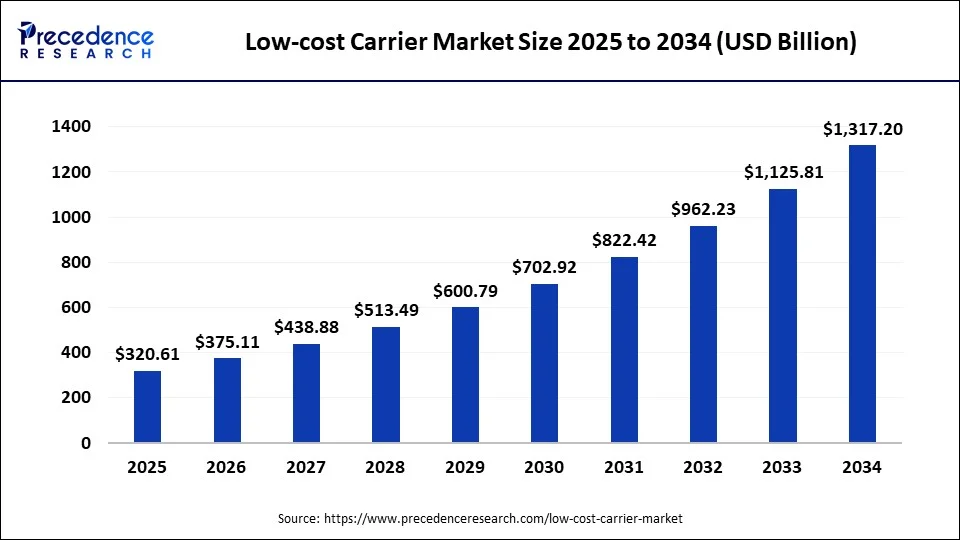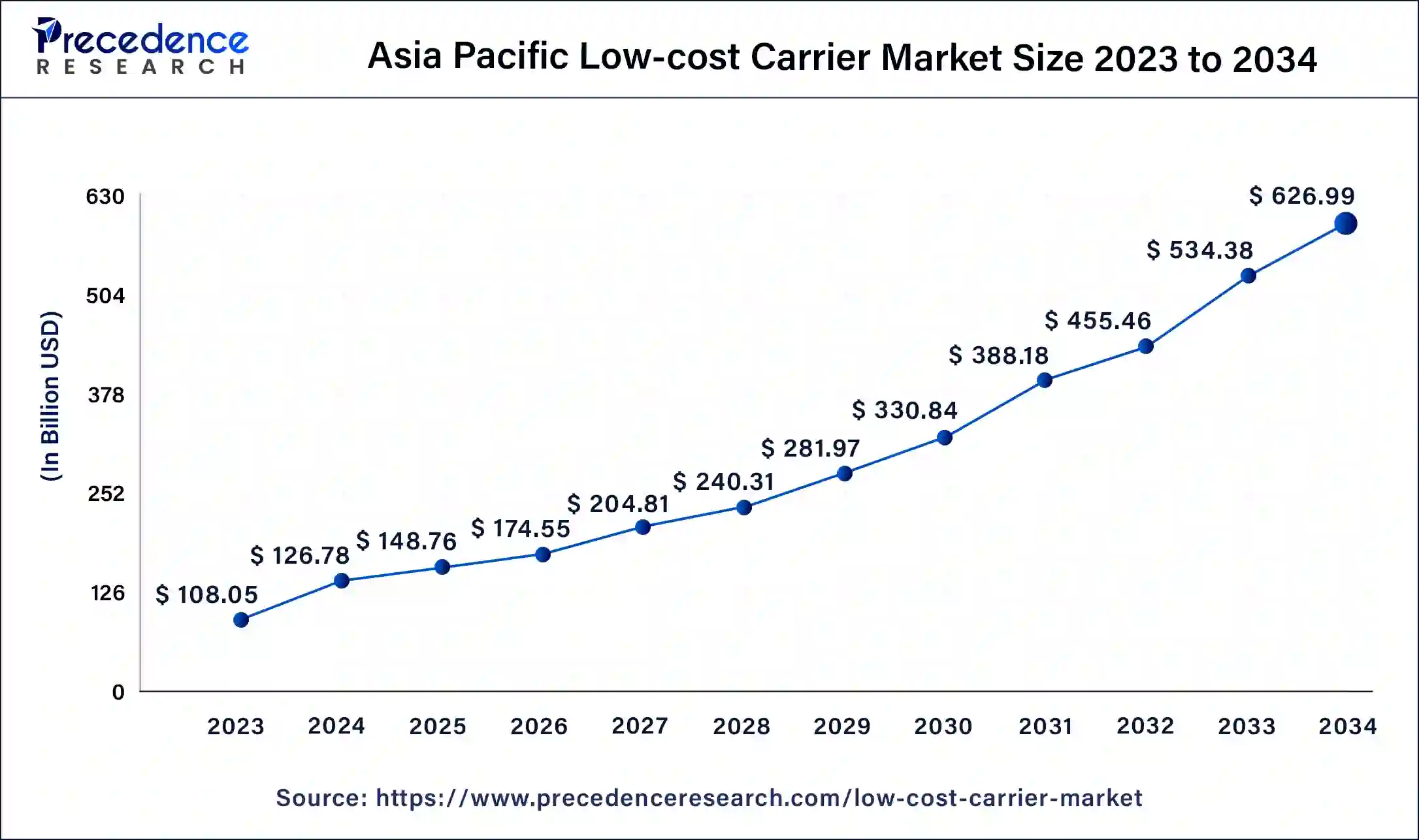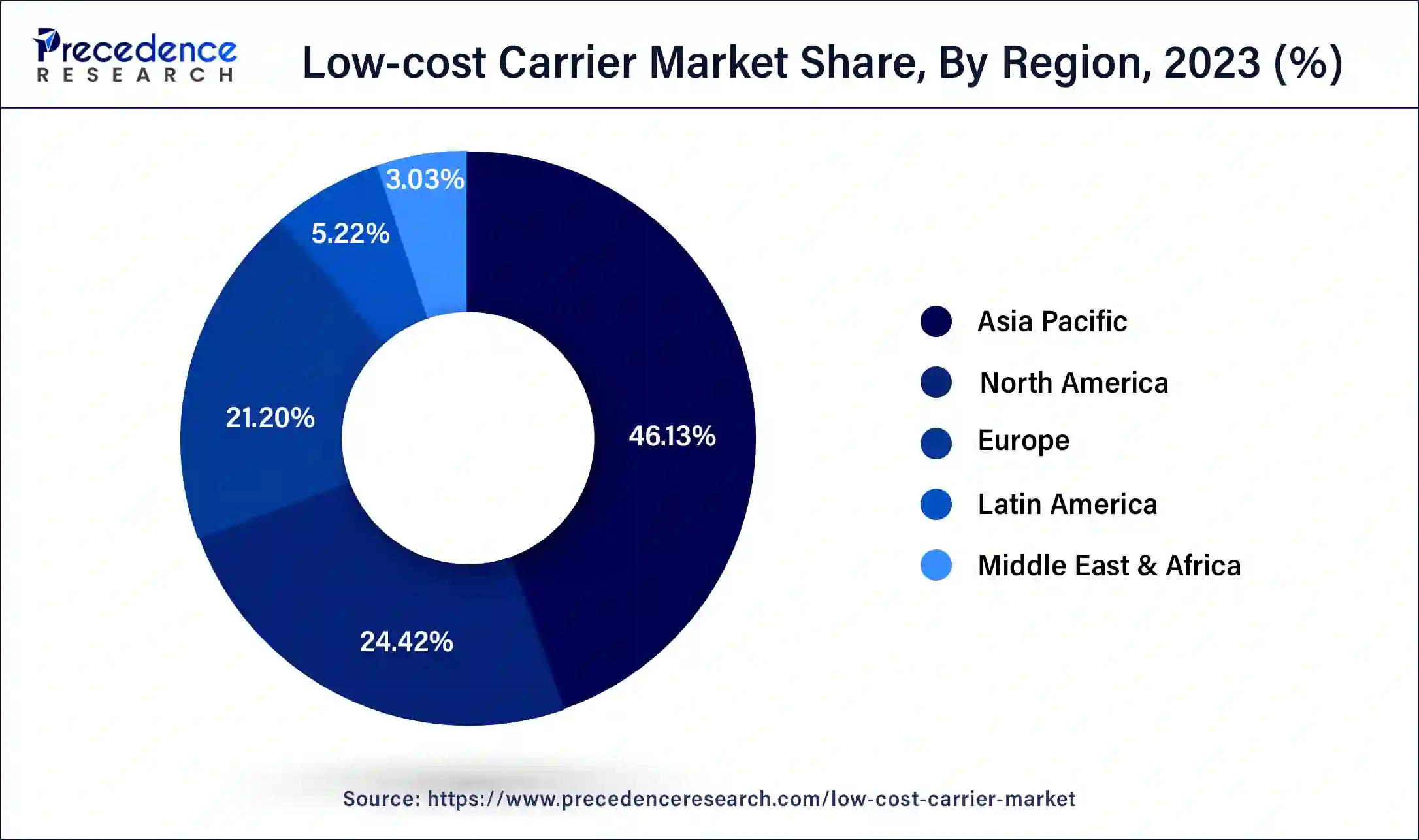List of Contents
Low-cost Carrier Market Size and Forecast 2025 to 2034
The global low-cost carrier market size accounted for USD 274.03 billion in 2024, and is expected to reach around USD 1,317.20 billion by 2034, expanding at a CAGR of 17% from 2025 to 2034.

Low-cost Carrier Market Key Takeaways
- In terms of revenue, the market is valued at $320.61 billion in 2025.
- It is projected to reach $1,317.20 billion by 2034.
- The market is expected to grow at a CAGR of 2% from 2025 to 2034.
- Asia Pacific dominated the global market with the largest market share of 46.13% in 2024.
- The north American region is expected to expand at market share between 2025 and 2034.
- By Aircraft Type, the Narrow body segment led the market with the largest market share of 72% in 2024.
- By Aircraft Type, the long-haul segment has held a revenue share of 28% in 2024.
- By Application, the individual segment dominated the market with the largest revenue share in 2024.
Asia Pacific Low-cost Carrier Market Size and Growth 2025 to 2034
The Asia Pacific low-cost carrier market size is estimated at USD 148.76 billion in 2025 and is predicted to be worth around USD 626.99 billion by 2034, at a CAGR of 17.3% from 2025 to 2034.

Asia Pacific dominated the market with the largest market share in 2024,the market in Asia Pacific is expected to maintain its position during the forecast period. The growth of the market is attributed to the increased population in the region. The increasing population mainly increased in middle-class and upper-middle-class populations is expected to drive the growth of the market in the region. The shift in lifestyle preferences and traveling habits would also be likely to fuel the growth of the aviation market. Increasing government initiatives for affordable air travel services mainly in countries such as China and India are predicted to highlight the market's growth in Asia Pacific.
North America is expected to increase its market share during the forecast period.The growth of the region is attributed to the increasing disposable income of the consumers in these regions. The United States carries 30% of the global domestic airline market. The growth of the low-cost carrier is due to its lower fare prices. The rising domestic flights for commercial and personal purposes along with the competitive nature of the overall aviation industry in the region promote the growth of the market.

Europe is expected to grow significantly in the low-cost carrier market during the forecast period. The growing tourism in Europe is increasing the demand for low-cost carriers. At the same time, the increasing online bookings and advancements in airports are decreasing the cost associated with travel and are encouraging the use of low-cost carriers. Thus, these developments, along with the government support, are promoting the market growth.
Market Overview
The low-cost carrier market is one of the leading segments in the global airline industry, the market revolves around offering cost-effective air traveling options. Low-cost carriers offer affordable traveling experiences, especially for short-distance travel. Such carriers also employ various cost-saving strategies to maintain affordability. These may include operating a single aircraft type to simplify maintenance or using secondary airports with lower fees and maximizing aircraft utilization through quick turnaround timings. Low-cost carriers (LCCs) have revolutionized the aviation industry by upending the status quo of the legacy flag carriers and revolutionizing the way that passengers are served.
Additionally, a lot of low-cost airlines only have one kind of aircraft in their fleet, which lessens the training needed for the crew. Some of them even land at minor airports in crowded cities rather than the busiest ones for affordability purposes. Market liberalization and the expansion of low-cost carriers have coexisted.
- Southwest Airlines, a leading player in the market stated its annual revenue for 2022 to be $23.81 billion, which is a 50.82% increase from the year 2021.
- In the quarter ending on 31st March 2023 revenue for Southwest Airlines was $5.706bn and an increase of 21.56% over the prior year.
- EasyJet reported revenue of $5.77bn, 64.89% higher than the industrial sector.
- In the first quarter ending revenue for JetBlue was $2.3bn and an increase of 34.1% over the prior year.
Low-cost Carrier Market Growth Factors
The low-cost carrier market is experiencing significant growth due to the increasing popularity of short-haul flights and the rising demand for domestic flights. The sustainable solution offered by low-cost carriers is observed as a growth factor for the market as sustainability concerns are growing across the globe. Airlines are concentrating on enhancing aircraft sustainability by lowering carbon emissions, utilizing sustainable aviation fuel, and using carbon capture technology. This is because sustainability is becoming a big concern. Additionally, growing analytics implementation to manage fixed assets, expanding asset management solution integration, and rising mobility solutions are the aspects that have been predictably predicted to positively impact the business of the global low-cost carrier market.
The low-cost carrier has opened broader options for the airline industry across the globe, it allows multiple services for passengers traveling for business purposes and even it has offered an opportunity for tourism businesses to grow. Such well-known advantages of low-cost carriers highlight the market's growth for the upcoming period.
Market Scope
| Report Coverage | Details |
| Market Size in 2025 | USD 320.61 Billion |
| Market Size in 2024 | USD 274.03 Billion |
| Market Size by 2034 | USD 1,317.20 Billion |
| Growth Rate from 2025 to 2034 | CAGR of 17% |
| Largest Market | Asia Pacific |
| Base Year | 2024 |
| Forecast Period | 2025 to 2034 |
| Segments Covered | Aircraft Type, Distribution Channel, Operations, Application, and Region |
| Regions Covered | North America, Europe, Asia-Pacific, Latin America, and Middle East & Africa |
Market Dynamics
Drivers
Rising demand for affordable air travel services
Passengers/tourists are observed to avoid air traveling options due to the hefty prices of tickets and taxes applied for the services. Airlines that offer low-cost carriers happen to establish a basic fare for the ticket that is cheap. These carriers even enable the passengers to choose their tickets according to the budget for reaching their destination. For instance, Frontier Airlines assesses extra fees for priority boarding, selecting your seat, and bag checking. Regular incentives are also provided by low-cost carriers.
The low-cost carriers often rely on the direct sales of tickets, this offers cost-effective distribution channels for the airline companies by making the traveling option affordable. Moreover, the cost-conscious approach, utilization of secondary airports, high load factors, and simplified services and operations collectively make the journey with low-cost carriers affordable. Thus, the rising demand for affordable air travel is observed to propel the growth of the market during the forecast period.
Restraints
Lack of refund policies
The lack of refund policies with low-cost carrier services is observed to act as a major restraint for the market's growth. The airlines that offer low-cost carrier services frequently refuse to issue refunds. As a result, tourists are advised to plan their flights in advance and stick to them. Rescheduling might result in additional costs. When purchasing a low-cost plane ticket, the added costs might pile up. Baggage check fees, seat position fees, and processing costs are all possibly added to it, which sometimes may boost the overall price of the ticket. Such services often have stricter refund or cancellation policies as compared to traditional airline services that may offer a complete refund in case of cancellation. Low-cost carriers typically operate with a strong emphasis on cost control and operational efficiency. Offering flexible refund policies can increase administrative costs which may lead to revenue loss.
Opportunities
Increased collaboration between airlines
Cheaper airfares have increased demand for low-cost carrier services, which has boosted market competitiveness since more airlines are now vying for travelers. The low-cost carrier business model has also made it possible for carriers who had no incentive or desire to pursue new prospects to fly routes that had never before been serviced. Multiple business activities such as collaboration, partnerships and acquisitions are done to promote such businesses. Airlines now provide service to more locations as a result, enabling passengers to travel to more locations. Several major airline companies are focused on offering collaborative strategies to operate low-cost carrier services, this element is observed to open lucrative opportunities for the market's growth.
Aircraft Type Insights:
The narrow body segment dominated the market with the highest market share in 2024. The segment will continue its dominance due to the lower fare prices. The short-haul low-cost carrier operates on a maximum of four-hour routes. The low-cost carrier is preferably used for short routes rather than longer routes. Low-cost carriers mostly focused on the short-haul segment due to the higher profitability than the long-haul segment.
The wide body segment is anticipated to experience significant growth during the forecast period. The long-haul carriers contain more than 200 passengers at a time. They provide all the facilities to their passengers. The long-haul carrier includes the most popular aircraft like the Boeing 777 variant, a larger version of the 787, another larger version of the 767, the Airbus A330 variant, the Airbus A350 variants, Airbus A340 variants, Airbus A380, and the iconic Boeing 747.
Application Insights
The individual segment dominated the market with the highest revenue share in2024. The growth of the segment is attributed to the increasing use of low-cost carrier aircraft for tourism purposes. The larger amount of the population is looking for an affordable and quick source of transportation, this element is observed to promote the growth of the individual segment.
The commercial segment is expected to dominate the market with the highest share during the forecast period. The growth of the segment is attributed to the increasing commercialization across the world. Low-cost carriers offer many benefits with regard to the commercial traveler resulting in greater demand for the segment.
Low-cost Carrier Market Companies
- Southwest Airlines Co.
- AirAsia Group Berhad
- easyJet plc
- JetBlue Airways Corporation
- Norwegian Air Shuttle ASA
- Spirit Airlines, Inc.
- IndiGo
- Wizz Air Holdings plc
- Allegiant Travel Company
Recent Development
- In July 2025, to disrupt long-haul low-cost travel, an agreement of $12.25 billion was signed between AirAsia Berhad, which is a subsidiary of Capital A Berhad, with Airbus for the purchase of 50 A321XLR aircraft, along with rights for 20 more. Hence, to become the world's first low-cost narrow-body network carrier, which is expected to expand its reach throughout Europe, Asia, Central Asia, and the Middle East, this collaboration will be a strategic move. The goal of AirAsia is to carry 150 million guests annually by 2030, with a total of 1.5 billion since inception, will be supported by this launch, which is anticipated between 2028 and 2032.
- In June 2025, to redeem and earn miles when flying with flyadeal, which is the low-cost carrier of Saudia Group, a collaboration between flyadeal and the AlFursan loyalty program was announced. The current digital transformation of AlFursan, as well as the increasing operational footprint across domestic and international routes of flyadeal, will be supported by this collaboration. The agreement was signed by the Chief Executive Officer of flyadeal, Steven Greenway, and the Vice President of AlFursan Loyalty Program, Essam Akhonbay, where the Director General of Saudia Group, H.E. Engr. Ibrahim Al-Omar also attended this signing ceremony held at Saudia.
- In June 2023,Norse Atlantic Airways launched a flight between Rome and New York. The new flight is a low-cost traveling alternative for passengers in the summertime. The flights will be in operation on a Boeing 787 Dreamliner.
- In June 2023,Japan's All Nippon Airways CEO Shinichi Inoue said on the sidelines of an aviation conference in Istanbul want to expand their short and medium-haul fleet by 2023, especially the Boeing 787 planes.
- In June 2023,the low-cost carrier launched passenger flights on Almaty-Tashkent routes by Uzbekistan My Freighter. They will be opening 3 times a week between Almaty and Tashkent.
- In June 2023,WestJet announced that it is planning to integrate Sunwing Airlines as a low-cost carrier in its main business within 2 years. According to the news, WestJet's current priority remains the acquisition of Swoop in the company's business.
Segments Covered in the Report
By Aircraft Type
- Narrow Body
- Wide Body
By Distribution Channel
- Online
- Travel Agency
By Operations
- Domestic
- International
By Application
- Individual
- Commercial
By Region
- North America
- Europe
- Asia-Pacific
- Latin America
- Middle East and Africa
For inquiries regarding discounts, bulk purchases, or customization requests, please contact us at sales@precedenceresearch.com
Frequently Asked Questions
Ask For Sample
No cookie-cutter, only authentic analysis – take the 1st step to become a Precedence Research client